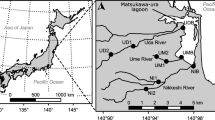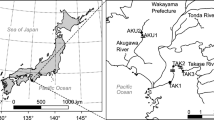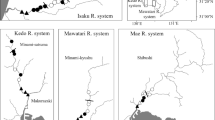Abstract
The rivers and lakes of Japan have had a wide range of shoreline modifications for flood control and stabilization, but the effects of this on the ecology of Japanese eels, Anguilla japonica, is not known. To clarify possible effects of riverbank modifications on yellow-phase Japanese eels in the lower Tone River, Japan, the abundance, condition factor and stomach contents were investigated using 586 eels collected in both revetment and natural shore areas at four sites. Eel abundances and their condition factors were higher in the natural shore areas than those of revetment areas at the three freshwater sites, and the smallest sizes of eels appeared to prefer the natural areas at all sites. The number of feeding eels, their food consumption, and the diversity of consumed prey were also generally greater in the natural shore areas than in the revetment areas. Other differences in diet were observed, such as terrestrial oligochaetes only being eaten by eels at the freshwater river natural shore areas and bivalves being eaten more in the revetment areas of those sites. In contrast, in the brackish habitat eels appeared to be less affected by concrete revetment with wave-dissipating tetrapod blocks. The range of differences found between the freshwater sampling areas suggest that revetment shorelines are used less by eels, particularly smaller eels, when natural shore areas are available, and eels that live near revetment have a lower abundance and diversity of prey to feed on.







Similar content being viewed by others

References
Aoyama J, Sasai S, Miller MJ, Shinoda A, Nakamura A, Kawazu K, Tsukamoto K (2002) A preliminary study of the movements of yellow and silver eels, Anguilla japonica, in the estuary of the Fukui River, Japan, as revealed by acoustic tracking. Hydrobiol 470:31–36
Aoyama J, Shinoda A, Sasai S, Miller MJ, Tsukamoto K (2005) First observations of the burrows of Anguilla japonica. J Fish Biol 67:1534–1543
Baras E, Jeandrain D, Serouge B, Philippart JC (1998) Seasonal variations in time and space utilization by radio-tagged yellow eels Anguilla anguilla (L.) in a small stream. Hydrobiol 372:187–198
Beumer JP (1979) Feeding and movement of Anguilla australis and Anguilla reinhardtii in Macleods Morass, Victoria, Australia. J Fish Biol 14:573–592
Bonhommeau S, Chassot E, Planque B, Rivot E, Knap AH, Le Pape O (2008) Impact of climate on eel populations of the Northern Hemisphere. Mar Ecol Prog Ser 373:71–80
Bouchereau J, Marques C, Pereira P, Guelorget O (2009) Feeding behaviour of Anguilla anguilla and trophic resources in the Ingril Lagoon (Mediterranean, France). Cah Biol Mar 50:319–332
Bozeman EL, Helfman GS, Richardson T (1985) Population size and home range of American eels in a Georgia tidal creek. Trans Am Fish Soc 114:821–825
Buchanan BP, Nagle GN, Walter MT (2014) Long-term monitoring and assessment of a stream restoration project in central New York. River Res Appl 30:245–258
Bunn SE, Arthington AH (2002) Basic principles and ecological consequences of altered flow regimes for aquatic biodiversity. Environ Manag 30:492–507
Casselman MJ (2003) Dynamics of resources of the American eel, Anguilla rostrata: declining abundance in the 1990s. In: Aida K, Tsukamoto K, Yamauchi K (eds) Eel biology. Springer, Tokyo, pp 255–274
Chisnall BL, Kalish JM (1993) Age validation and movement of freshwater (Anguilla dieffenbachii and A. australis) in a New Zealand pastoral stream. New Zeal J Mar Freshw Res 27:333–338
Cooke S, Paukert C, Hogan Z (2012) Endangered river fish: factors hindering conservation and restoration. Endanger Species Res 17:179–191
Davidson D, Marshall CT (2010) Are morphometric indices accurate indicators of stored energy in herring Clupea harengus? J Fish Biol 76:913–929
Dekker W, Casselman JM, Cairns DK, Tsukamoto K, Jellyman D, Lickers H (2003) Worldwide decline of eel resources necessitates immediate action—Quebec declaration of concern. Fish 28:28–30
DeLeo GA, Gatto M (1996) Trends in vital rates of the European eel: evidence for density dependence? Ecol Appl 6:1281–1294
Denoncourt CE, Stauffer JRJ (1993) Feeding selectivity of the American eel Anguilla rostrata (LeSueur) in the upper Delaware River. Am Midl Nat 129:301–308
Dörner H, Skov C, Berg S, Schulze T, Beare DJ, Van der Velde G (2009) Piscivory and trophic position of Anguilla anguilla in two lakes: importance of macrozoobenthos density. J Fish Biol 74:2115–2131
Fausch KD, Northcote TG (1992) Large woody debris and salmonid habitat in a small coastal British Columbia stream. Can J Fish Aquat Sci 49:682–693
Feunteun E (2002) Management and restoration of European eel population (Anguilla anguilla): an impossible bargain. Ecol Eng 18:575–591
Ford TE, Mercer E (1986) Density, size distribution and home range of American eels, Anguilla rostrata, in a Massachusetts salt marsh. Environ Biol Fishes 17:309–314
Froese R (2006) Cube law, condition factor and weight-length relationships: history, meta-analysis and recommendations. J Appl Ichthyol 22:241–253
Fukuda N, Miller MJ, Aoyama J, Shinoda A, Tsukamoto K (2013) Evaluation of the pigmentation stages and body proportions from the glass eel to yellow eel in Anguilla japonica. Fish Sci 79:425–438
Han YS, Tzeng WN (2007) Sex-dependent habitat use by the Japanese eel Anguilla japonica in Taiwan. Mar Ecol Prog Ser 338:193–198
Han YS, Liao IC, Huang YS, He JT, Chang CW, Tzeng WN (2003) Synchronous changes of morphology and gonadal development of silvering Japanese eel Anguilla japonica. Aquaculture 219:783–796
Han YS, Tzeng WN, Liao IC (2009) Time series analysis of Taiwanese catch data of Japanese glass eels Anguilla japonica: possible effects of the reproductive cycle and El Niño events. Zool Stud 48:632–639
Haro A, Richkus W, Whalen K, Hoar A, Busch WD, Lary S, Brush T, Dixon D (2000) Population decline of the American eel: implications for research and management. Fish 25:7–16
Hedger RD, Dodson JJ, Hatin D, Caron F, Fournier D (2010) River and estuary movements of yellow-stage American eels Anguilla rostrata, using a hydrophone array. J Fish Biol 76:1294–1311
Helfman GS, Stoneburner DL, Bozeman EL, Christian PA, Whalen R (1983) Ultrasonic telemetry of American eel movements in a tidal creek. Trans Am Fish Soc 112:105–110
Hyslop EJ (1980) Stomach contents analysis—a review of methods and their application. J Fish Biol 17:411–429
Itakura H, Kitagawa T, Miller MJ, Kimura S (2014) Declines in catches of Japanese eels in rivers and lakes across Japan: Have river and lake modifications reduced fishery catches? Landsc Ecol Eng. doi:10.1007/s11355-014-0252-0
Jellyman DJ (1989) Diet of two species of freshwater eel (Anguilla spp.) in Lake Pounui, New Zealand. New Zeal J Mar Freshw Res 23:1–10
Jellyman DJ, Sykes JRE (2003) Diel and seasonal movements of radio-tagged freshwater eels, Anguilla spp., in two New Zealand streams. Environ Biol Fishes 66:143–154
Kaifu K, Tamura M, Aoyama J, Tsukamoto K (2010) Dispersal of yellow phase Japanese eels Anguilla japonica after recruitment in the Kojima Bay-Asahi River system, Japan. Environ Biol Fishes 88:273–282
Kaifu K, Miller MJ, Yada T, Aoyama J, Washitani I, Tsukamoto K (2013a) Growth differences of Japanese eels Anguilla japonica between fresh and brackish water habitats in relation to annual food consumption in the Kojima Bay-Asahi River system, Japan. Ecol Freshw Fish 22:127–136
Kaifu K, Miyazaki S, Aoyama J, Kimura S, Tsukamoto K (2013b) Diet of Japanese eels Anguilla japonica in the Kojima Bay-Asahi River system, Japan. Environ Biol Fishes 96:439–446
Kanazawa K, Miyake Y (2006) Comparison of stream invertebrate assemblages between concrete and natural substrates. Ecol Civil Eng 9:141–150
Kawakami Y, Mochioka N, Nakazono (1999) A Immigration patterns of glass eels Anguilla japonica entering river in Northern Kyushu, Japan. Bull Mar Sci 64:315–327
Kim H, Kimura S, Shinoda A, Kitagawa T, Sasai Y, Sasaki H (2007) Effect of El Niño on migration and larval transport of the Japanese eel (Anguilla japonica). ICES J Mar Sci 64:1387–1395
Kimura S, Tsukamoto K, Sugimoto T (1994) A model for the larval migration of the Japanese eel—roles of the trade winds and salinity front. Mar Biol 119:185–190
Kimura S, Doos K, Coward AC (1999) Numerical simulation to resolve the issue of downstream migration of the Japanese eel. Mar Ecol Prog Ser 186:303–306
Kimura S, Inoue T, Sugimoto T (2001) Fluctuation in the distribution of low-salinity water in the North Equatorial current and its effect on the larval transport of the Japanese eel. Fish Oceanogr 10:51–60
Kotake A, Arai T, Okamura A, Yamada Y, Utoh T, Oka HP, Miller MJ, Tsukamoto K (2007) Ecological aspects of the Japanese eel, Anguilla japonica, collected from coastal areas of Japan. Zoolog Sci 24:1213–21
Krebs CJ (1998) Species diversity measures. In: Longman AW(ed) Ecological Methodology. 2nd ed. Menlo Park California
Krueger WH, Oliveira K (1999) Evidence for environmental sex determination in the American eel, Anguilla rostrata. Environ Biol Fishes 55:381–389
Kusakabe T, Ariyama H, Ohmi H, Amano T (2005) Comparison of feeding conditions in adult marbled rockfish Sebastiscus marmoratus between an inclined sea wall of Kansai International Airport and a natural rocky shore. Nippon Suisan Gakkaishi 71:594–600
LaBar GW, Facey DE (1983) Local movements and inshore populations sizes of American eels in Lake Champlain, Vermont. Trans Am Fish Soc 112:114–116
Labar GW, Casal JAH, Delgado CF (1987) Local movements and population size of European eels, Anguilla anguilla, in a small lake in southwestern Spain. Environ Biol Fishes 19:111–117
Lammens E, DeNie H, Vijverberg J, van Densen W (1985) Resource partitioning and niche shifts of bream (Abramis brama) and eel (Anguilla anguilla) mediated by predation of smelt (Osmerus eperlanus) on Daphnia hyalina. Can J Fish Aquat Sci 42:1342–1351
Le Cren ED (1951) The length-weight relationship and seasonal cycle in gonad weight and condition in the Perch (Perca fluviatilis). J Anim Ecol 20:201–219
Machut LS, Limburg KE, Schmidt RE, Dittman D (2007) Anthropogenic impacts on American eel demographics in Hudson River tributaries, New York. Trans Am Fish Soc 136:1699–1713
Michel P, Oberdorff T (1995) Feeding habits of fourteen European freshwater fish species. Cybium 19:5–46
Mikami S, Nakane Y, Sano M (2011) Influence of offshore breakwaters on fish assemblage structure in the surf zone of a sandy beach in Tokyo Bay, central Japan. Fish Sci 78:113–121
Miller MJ, Kimura S, Friedland KD, Knights B, Kim H, Jellyman DJ TK (2009) Review of ocean-atmospheric factors in the Atlantic and Pacific oceans influencing spawning and recruitment of anguillid eels. In: Challenges for Diadromous Fishes in a Dynamic Global Environment. Am Fish Soc Symp 69. p 231–249
Ministry of Agriculture Forestry and Fisheries, Japan (1954–2006) Annual report of catch statistics on fishery and aquiculture. Ministry of Agriculture Forestry and Fisheries, Tokyo
Moore KMS, Gregory SV (1988) Response of young-of-the-year cutthroat trout to manipulation of habitat structure in a small stream. Trans Am Fish Soc 117:162–170
Morrison WE, Secor DH (2003) Demographic attributes of yellow-phase American eels (Anguilla rostrata) in the Hudson River estuary. Trans Am Fish Soc 60:1487–1501
Morrison WE, Secor DH (2004) Abundance of yellow-phase American Eels in the Hudson River Estuary. Trans Am Fish Soc 133:896–910
Mosegaard K, Holmgren H (1996) Implications of individual growth status on the future sex of the European eel. J Fish Biol 49:910–925
Nakamura K, Tockner K, Amano K (2006) River and wetland restoration: lessons from Japan. Bioscience 56:419
Nakano D, Nagayama S, Kawaguchi Y, Nakamura F (2008) River restoration for macroinvertebrate communities in lowland rivers: insights from restorations of the Shibetsu River, north Japan. Landsc Ecol Eng 4:63–68
Nihira A (2006) Catch fluctuations of Japanese eel Anguilla japonica in the Tone River and Lake Kasumigaura. Res Rep Ibaraki Prefect Freshwater Fish Res Inst 40:55–68
Okamura A, Yamada Y, Yokouchi K, Horie N, Mikawa N, Utoh T, Tanaka S, Tsukamoto K (2007) A silvering index for the Japanese eel Anguilla japonica. Environ Biol Fishes 80:77–89
Oliveira K (1997) Movements and growth rates of yellow-phase American eels in the Annaquatucket River, Rhode Island. Trans Am Fish Soc 126:638–646
Onikura N, Nakajima J, Eguchi K, Miyake T, Nishida T, Inui R, Kenmochi T, Sugimoto Y, Kawamura K, Oikawa S (2007) Relationships between presence and populations of freshwater fishes and revetment conditions in creeks around Sea of Ariake, northwestern Kyushu, Japan. J Japan Soc Water Environ 30:277–282
Osugi T, Tate S, Takemura K, Watanabe W, Ogura N, Kikkawa J (2007) Ecological research for the restoration and management of rivers and reservoirs in Japan. Landsc Ecol Eng 3:159–170
Otake T, Miller MJ, Inagaki T, Minagawa G, Shinoda A, Kimura Y, Sasai S, Oya M, Tasumi S, Suzuki Y, Uchida M, Tsukamoto K (2006) Evidence for migration of metamorphosing larvae of Anguilla japonica in the Kuroshio
Palmer MA, Bernhardt ES, Allan JD, Lake PS, Alexander G, Brooks S, Carr J, Clayton S, Dahm CN, Follstad Shah J, Galat DL, Loss SG, Goodwin P, Hart DD, Hassett B, Jenkinson R, Kondolf GM, Lave R, Meyer JL, O’Donnell TK, Pagano L, Sudduth E (2005) Standards for ecologically successful river restoration. J Appl Ecol 42:208–217
Pianka E (1973) The structure of lizard communities. Annu Rev Ecol Syst 4:53–74
Roncarati A, Melotti P, Mordenti O, Gennari L (1997) Influence of stocking density of European eel (Anguilla anguilla, L.) elvers on sex differentiation and zootechnical performances. J Appl Ichthyol 13:131–136
Shimatani Y, Oguri S, Kayaba Y (1994) Impact of stream modification on habitat component and fish in Tagawa River. Suikougaku Ronbunshuu 38:337–344
Sloane RD (1984) Distribution, abundance, growth and food of freshwater eels (Anguilla spp.) in the Douglas River, Tasmania. Aust J Mar Freshw Res 35:325–339
Strayer DL, Findlay SEG, Miller D, Malcom HM, Fischer DT, Coote T (2012) Biodiversity in Hudson River shore zones: influence of shoreline type and physical structure. Aquat Sci 74:597–610
Takahashi G, Higashi S (1984) Effect of channel alteration on fish habitat. Jpn J Limnol (Rikusuigaku Zasshi) 45:178–186
Takahasi Y, Uitto JI (2004) Evolution of river management in Japan: from focus on economic benefits to a comprehensive view. Glob Environ Chang 14:63–70
Taniguchi Y, Inoue M, Kawaguchi Y (2001) Stream fish habitat science and management in Japan: a review. Aquat Ecosyst Health Manag 4:357–365
Tatsukawa K (2003) Eel resources in East Asia. In: Aida K, Tsukamoto K, Yamauchi K (eds) Eel biology. Springer, Tokyo, pp 293–298
Tesch FW (1968) Age and growth. In: Ricker WE (ed) Methods for Assessment of fish production in fresh waters. Blackwell scientific Publications, Oxford, pp 93–123
Tesch FW (2003) The eel biology and management of anguillid eels. Blackwell science, London
Tomie JPN, Cairns DK, Courtenay SC (2013) How American eels Anguilla rostrata construct and respire in burrows. Aquat Biol 19:287–296
Tsukamoto K (1990) Recruitment mechanism of the eel, Anguilla japonica, to the Japanese coast. J Fish Biol 36:659–671
Tsukamoto K (1992) Discovery of the spawning area for Japanese Eel. Nature 356:789–791
Tsukamoto K (2009) Oceanic migration and spawning of anguillid eels. J Fish Biol 74:1833–1852
Tsukamoto K, Arai T (2001) Facultative catadromy of the eel Anguilla japonica between freshwater and seawater habitats. Mar Ecol Prog Ser 220:265–276
Tsukamoto K, Nakai I, Tesch WV (1998) Do all freshwater eels migrate? Nature 396:635–636
Tsukamoto K, Aoyama J, Miller MJ (2009) The present status of the Japanese eel: resources and recent research. In: Casselman J, Cairns D (eds) Eels at the edge. Bethesda, Maryland, p 21–35 (Am Fish Soc Symp 58)
Tsukamoto K, Chow S, Otake T, Kurogi H, Mochioka N, Miller MJ, Aoyama J, Kimura S, Watanabe S, Yoshinaga T, Shinoda A, Kuroki M, Oya M, Watanabe T, Hata K, Ijiri S, Kazeto Y, Nomura K, Tanaka H (2011) Oceanic spawning ecology of freshwater eels in the western North Pacific. Nat Commun 2:179
Tzeng WN, Cheng PW, Lin FY (1995) Relative abundance, sex ratio and population structure of the Japanese eel Anguilla japonica in the Tanshui River system of northern Taiwan. J Fish Biol 46:183–201
Tzeng WN, Shiao JC, Iizuka Y (2002) Use of otolith Sr:Ca ratios to study the riverine migratory behaviors of Japanese eel Anguilla japonica. Mar Ecol Prog Ser 245:213–221
Usuda H, Morita T, Hasegawa M (2012) Impacts of river alteration for flood control on freshwater turtle populations. Landsc Ecol Eng 8:9–16
Van Liefferinge C, Dillen A, Ide C, Herrel A, Belpaire C, Mouton A, de Deckere E, Meire P (2012) The role of a freshwater tidal area with controlled reduced tide as feeding habitat for European eel (Anguilla anguilla, L.). J Appl Ichthyol 28:572–581
Verreault G, Dumont P, Mailhot Y (2004) Habitat losses and anthropogenic barriers as a cause of population decline for American eel (Anguilla rostrata) in the St. Lawrence watershed, Canada. ICES C
Ward JV, Tockner K, Schiemer F (1999) Biodiversity of floodplain river ecosystems: ecotones and connectivity. Regul Rivers Res Manag 15:125–139
Wasserman R, Pereira-da-Conceicoa L, Strydom N, Weyl O (2012) Diet of Anguilla mossambica (Teleostei, Anguillidae) elvers in the Sundays River, Eastern Cape, South Africa. Afr J Aquat Sci 37:347–349
Wolter C (2001) Conservation of fish species diversity in navigable waterways. Landsc Urban Plan 53:135–144
Yokouchi K, Aoyama J, Oka HP, Tsukamoto K (2008) Variation in the demographic characteristics of yellow-phase Japanese eels in different habitats of the Hamana Lake system, Japan. Ecol Freshw Fish 17:639–652
Yokouchi K, Fukuda N, Miller MJ, Aoyama J, Daverat F, Tsukamoto K (2012) Influences of early habitat use on the migratory plasticity and demography of Japanese eels in central Japan. Estuar Coast Shelf Sci 107:132–140
Yoshimura C, Omura T, Furumai H, Tockner K (2005) Present state of rivers and streams in Japan. River Res Appl 21:93–112
Zenimoto K, Kitagawa T, Miyazaki S, Sasai Y, Sasaki H, Kimura S (2009) The effects of seasonal and interannual variability of oceanic structure in the western Pacific North Equatorial current on larval transport of the Japanese eel Anguilla japonica. J Fish Biol 74:1878–1890
Acknowledgments
This study was supported in part by the River Fund in charge of the Foundation of River and Watershed Environment Management (FOREM) in Japan, and was also supported in part by the Futaba Electronics Memorial Foundation. M.J. Miller helped to improve the manuscript. This study followed the animal experimental use guidelines of The University of Tokyo.
Author information
Authors and Affiliations
Corresponding author
Rights and permissions
About this article
Cite this article
Itakura, H., Kaino, T., Miyake, Y. et al. Feeding, condition, and abundance of Japanese eels from natural and revetment habitats in the Tone River, Japan. Environ Biol Fish 98, 1871–1888 (2015). https://doi.org/10.1007/s10641-015-0404-6
Received:
Accepted:
Published:
Issue Date:
DOI: https://doi.org/10.1007/s10641-015-0404-6



